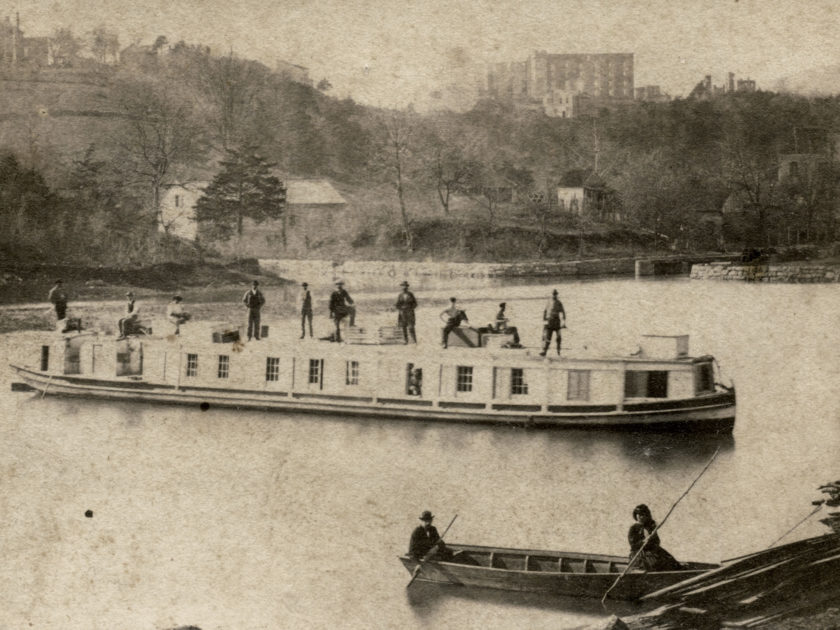By Warren “H” Shindle
Since the earliest days of photography, practitioners created non-continuous sweeping outdoor views with multiple exposures. These separate, patch-worked together images documented city landscapes, such as a well-known 1851 daguerreian view of San Francisco.
While continuous panoramic scenes produced by specialized cameras were more than four decades into the future, these cartes de visite are representative of 1860’s technology.
Though these cartes may not be considered especially unusual from a technical standpoint, they do capture details that might not have been readily apparent during their initial exposures. The view here, when placed end-to-end, is an early rare Southern Virginia landscape. In its foreground is the packet boat Marshall, which carried the remains of Confederate Maj. Gen. Thomas J. “Stonewall” Jackson home to The Virginia Military Institute (VMI) and his final resting place in May 1863.

The carte on the left, examples of which are also available in the stereoview format, was published as early as 1936. Front and center sits the Marshall, named after the first James River & Kanawha Canal Director John Marshall, at Jordan’s Point in Lexington, Va., the furthest terminus of the James River & Kanawha Canal from the Confederate capital of Richmond along the North River, now known as the Maury River. This canal represented part of President George Washington’s vision of a grand water transportation route from the Atlantic Ocean to the Mississippi River. The Lexington section was completed in 1852. The first mule-drawn packet arrived in November 1860, with travel between Richmond and Lexington taking less than 33 hours over the 147-mile route.

Christened in 1861, the Marshall measured 92 feet in length. It included staterooms, a dining room and sleeping compartments that could accommodate 60 passengers. It also included quarters for the captain and crew, with additional space for a mule team. Various period accounts refer to the Marshall as the “most luxurious mode of travel for those days,” “the finest boat at the time” and “The Queen of James River & Kanawha Fleet.”
Also pictured in the carte on the left, on a ridge above and to the right, are the ruins of VMI. Union Maj. Gen. David Hunter destroyed the campus during a cavalry raid in June 1864, in retribution for the participation of its cadets a month earlier at the nearby Battle of New Market. The cadets and regular Confederate forces soundly defeated federals commanded by Maj. Gen. Franz Sigel on May 15.

Hunter also sacked Lexington and Jordan’s Point. Below VMI, one can see Jordan’s Point and its canal storage warehouses, wharf, gristmill and cotton mill. An 1873 map of Jordan’s Point was used to identify the buildings.
Col. John Jordan, a veteran of the War of 1812, and his extended family owned and operated much of Jordan’s Point. He also ran local iron smelting operations where his father had produced cannonballs for patriots during the American Revolution. The ruins of Jordan’s mansion, originally known as “Jordan’s Point” and now as “Stono,” sit to the left of VMI. Built in 1818 in the Greek Revival style with Federal attributes, the residence features a full height entry portico with associated columns.
The previously unknown carte on the right shows the reconstructed bridge that replaced a covered bridge that Lexington citizens torched as a deterrent to Hunter’s raid. The dam that powered the grist, saw and cotton mills at Jordan’s Point is also evident. Faintly looming in the distance is “House” Mountain, familiar to every present-day VMI cadet. The canal basin rock wall that rings Jordan’s Point matches both cartes, and helps align this combined view.

The scene created by the cartes relates to the life and death of Jackson. Leaving VMI in 1861 as a Confederate major, Jackson led the cadets, whom he had taught artillery tactics and natural philosophy, to Richmond. There, the cadets served as drill instructors for the newly formed Confederate army. In two years, Jackson achieved unwelcome military fame, always crediting all the glory to “God alone,” after his stellar leadership at the First Battle of Manassas, the victorious 1862 Valley Campaign, the capture of Harper’s Ferry, fighting at Sharpsburg, and a bold flanking movement during the Battle of Chancellorsville. On May 2, 1863, at Chancellorsville, North Carolina troops in his command accidently shot Jackson three times. Eight days later, he succumbed to complications from the amputation of his arm and other injuries.
The Marshall proved the logical choice to transport his body and the accompanying funeral procession on the last leg of its journey from Lynchburg to Lexington, as no railway served the town. On the afternoon of May 13, Jackson’s body arrived at Lynchburg via the Orange & Alexandria Railroad from Charlottesville. At 5 p.m., a funeral procession carried the casket down to the canal landing where the Marshall awaited, passing the loyal citizenry of Lynchburg and approximately 1,500 Confederate soldier convalescents from local hospitals.
Members of the procession that boarded the boat for the night trip to Lexington included the late general’s wife, Anna, his infant daughter, Julia (nicknamed “Little Miss Stonewall”), Virginia Gov. John Letcher, Jackson’s staff doctor, Hunter McGuire, and Lt. Col. Scott Shipp, VMI’s Commandant. Also on board were the remains of Confederate Brig. Gen. Elisha F. Paxton. A Lexington native, Paxton suffered a mortal wound at Chancellorsville the day after Jackson was shot.
Upon the arrival of the funeral party at Jordan’s Point later the next day, according to one source, “They were met in Lexington by VMI Cadets and a large concourse of people. The casket was placed on a caisson and pulled to the Institute.” The following day, May 15, Jackson was buried in his family plot in the town cemetery.
Considered as a single image, the content of the carte on the right appears much less interesting than its companion image. The sum total of the content of the combined view, however, is greater than either image.
I acquired the previously known carte on the left in 1994 from Lexington book dealer and my mentor, Bob Lurate. I discovered the other carte, previously unknown, unpublished and unmarked, at a Civil War show many years later.
Considered as a single image, the content of the carte on the right appears much less interesting than its companion image. The sum total of the content of the combined view, however, is greater than either image.
The images date to the early fall of 1865. This conclusion is based upon the observations of the river’s completed bridge, reconstructed in late 1864. The full tree foliage, heavier civilian attire and unreconstructed VMI buildings (rebuilding began in 1866) also offer clues that help date the scene. Neither carte bears a photographer’s imprint nor carries tax revenue stamp.
While no conclusive evidence exists about the photographer’s identity, a number of photographers—Michael Miley, A.H. Plecker, Isaac N. White, Samuel Pettigrew, Tanner & VanNess of Lynchburg and Joseph Kelly—operated in the Lexington area during this period.
Noted Lexington Historian and Washington and Lee University Senior Special Collections Assistant Seth McCormick-Goodhart observes that the left “image of the point itself is the earliest known photograph of Jordan’s Point.” Moreover, he feels that the cartes “are possibly by Miley or A. H. Plecker in the summer-fall of 1866. Plecker created many images of the James River and Kanawha canal from Lynchburg through to Rockbridge County during the period.”
McCormick-Goodhart further noted that Miley might have purchased Plecker’s negatives after Plecker left Lexington on Jan. 1, 1867. “The best piece of evidence, is a duplicative scene in stereoview format of the Marshall with a Boude and Miley stamp,” which tilts the attribution in Miley’s favor.
References: Henry Boley, Lexington in Old Virginia; Farnam, Map of Jordan’s Point. Lexington, Va.; Catherine M. Gilliam, Rockbridge Historical Society: Volume Nine of The Proceedings, 1975-79; Seth McCormick-Goodhart email to the author, Sept. 22, 2017; Beatrice J. Hehl, “Queen of The James River and Kanawha Fleet: The Packet Boat Marshall’s Immortality,” Lynchburg Magazine (1970); Anne B. Heiner, Rockbridge Historical Society: Volume Seven of The Proceedings, 1966-1969; James W. McClung, Historical Significance Of Rockbridge County, Virginia; City of Lynchburg Assistant Curator Roswitha Rash to the author, Feb. 29, 1996; William G. Sower, Facts About The Packet Boat Marshall, Information Data Sheet; Daily Advance (Lynchburg, Va.), Feb. 8 and 10, 1960; Lippincott’s Magazine, March 1873; Miscellaneous undated newspaper clippings and other materials in the author’s possession.
MAJ Warren “H” Shindle, Corps of Engineers, USAR (Ret), graduated from Virginia Military Institute in 1985 with a Mechanical Engineering Degree. Shindle is also a professional engineer and a licensed auctioneer in Virginia. He has collected and researched VMI Cadet images for more than 30 years, and will provide “VMI Faces” in forthcoming Military Images issues. Please consider forwarding your VMI Cadets for his continued research (wwshindle@hotmail.com).
SPREAD THE WORD: We encourage you to share this story on social media and elsewhere to educate and raise awareness. If you wish to use any image on this page for another purpose, please request permission.
LEARN MORE about Military Images, America’s only magazine dedicated to showcasing, interpreting and preserving Civil War portrait photography.
VISIT OUR STORE to subscribe, renew a subscription, and more.

